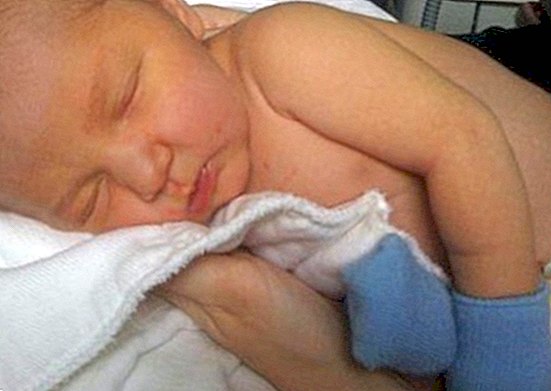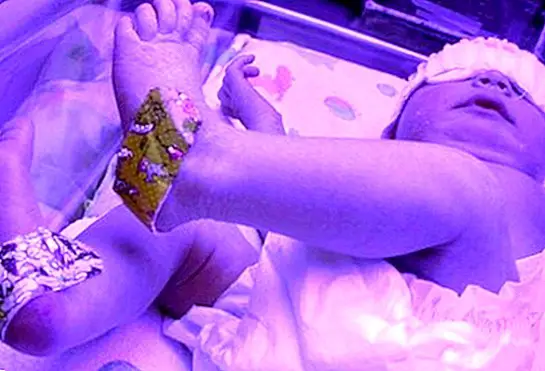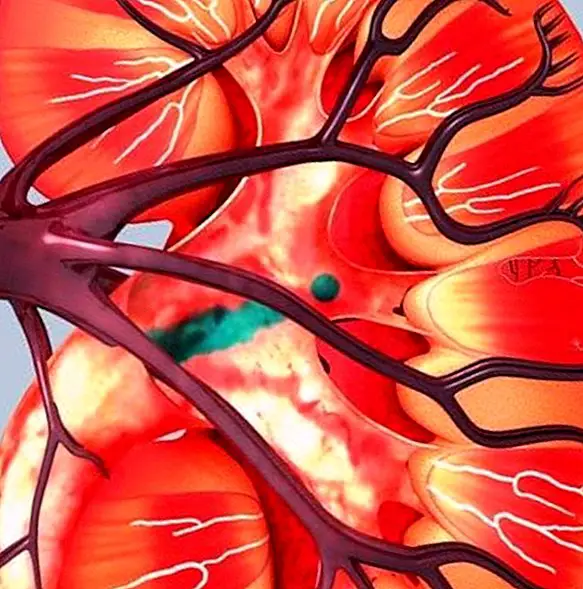Bilirubin and jaundice in newborns
When we talk about the different functions of the gallbladder we should also talk about the bile, a greenish-yellow liquid originally produced by hepatic cells or hepatocytes, which fulfills the function of helping in the process of digestion, and in turn facilitating the absorption of fats.
The bilirubin -Which is a compound that results from the degradation of hemoglobin in red blood cells- consists of a yellowish pigment found in bile, a liquid that, in addition to bilirubin, contains other substances such as cholesterol and bile acids.

When the bilirubin increases in the blood can lead to the presence of jaundice, a condition that causes a yellow coloration both on the skin and in the eyes (specifically in the sclera, that is to say in the white of the eye) and in the different mucous membranes.
It is a frequent disorder in the newly born, so that it is usual to observe a yellowish color in their skin and in the white of the eye, caused precisely by an excess of bilirubin in the blood.
Why does bilirubin increase and jaundice appears in newborns?
Since jaundice occurs when bilirubin accumulates in the blood, in the case of newborns it is mainly due to the fact that its small liver is not yet capable of breaking it down and eliminating it quickly enough, since it is still developing.
However, several causes can be established in turn:
- The intestines of the newborn reabsorb a larger amount of bilirubin before its elimination through the stool.
- As indicated before, the liver is still developing and is not at all capable of eliminating the amount of bilirubin in adequate blood so that it does not accumulate.
- Manufacture of a greater amount of bilirubin than adults, a normal condition since they renew red blood cells more often.
Types of jaundice in newborns
- Physiological jaundice: considered normal, is that which usually occurs in most newborns, as a result of the immaturity of the small child's liver. It appears between the second and fifth days of life, and tends to disappear when the newborn is between one and two weeks old.
- Jaundice associated with breast milk or lactation: jaundice may be caused by certain substances present in breast milk, or when the baby is not getting enough milk. This type of jaundice appears between the three and the first five days of life, gradually improving in the following weeks.
- Jaundice of prematurity: it is common for premature babies, taking longer to effectively regulate the elimination / excretion of bilirubin, present jaundice.
- Jaundice due to incompatibility of Rh or blood group: it is a type of jaundice that can be prevented if the mother is injected during the first 72 hours of the postpartum Rh immunoglobulin. Appears when the mother produces antibodies that destroy the baby's red blood cells, as a result of the newborn has a blood group different from that of his mother.
Main symptoms to consider
Jaundice tends to begin with the newborn's head, from which it gradually spreads to the rest of the body (face, chest, abdomen and legs), always in a downward direction. Appears especially between the second to the third day of life.
As a result, the skin of the newborn becomes yellowish, while the sclera (the white of the eye) may acquire a yellowish coloration.
What to do if my baby has jaundice?
Given that today it is usual for the mother and newborn to leave the hospital between one to two days after delivery (as long as no complications have occurred), if the parents observe the appearance of a skin discoloration in the somewhat yellowish baby is recommended to take them to the pediatrician. Even if you have doubts, it is advisable to take them between one to three days after leaving the hospital.
Treatment of jaundice in newborns
Only when the jaundice is important or does not return with the passage of the weeks, the pediatrician could recommend a treatment based on a special lamp -phototherapy- that helps your small organism to eliminate excess bilirubin.

In most cases, when the jaundice is mild or moderate, it tends to disappear between one to two weeks after birth, as the newborn begins to regulate the excess bilirubin alone.
If you want to know more about elevated bilirubin, we advise you to read our note dedicated to high bilirubin.
Image | holaratcha / woodleywonderworks This article is published for informational purposes only. You can not and should not replace the consultation with a Pediatrician.We advise you to consult your trusted pediatrician. ThemesNewborn


